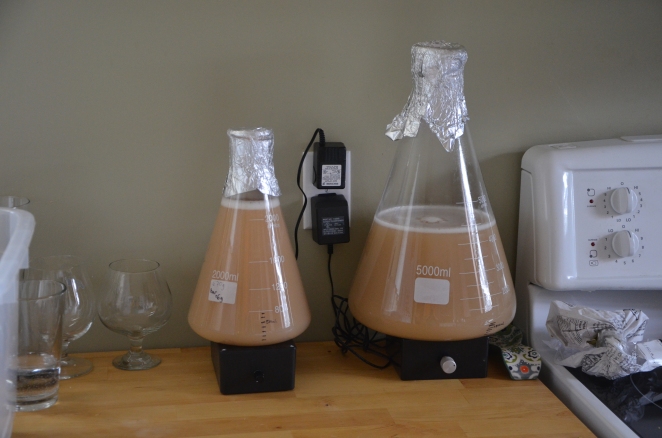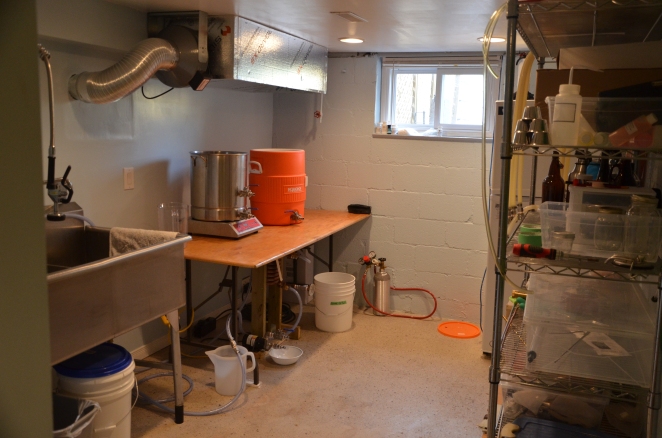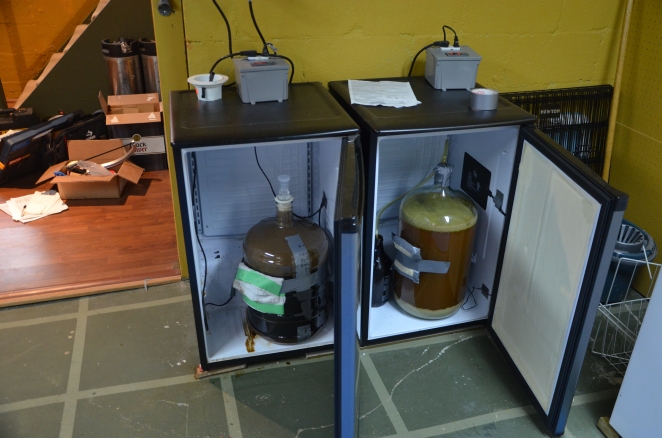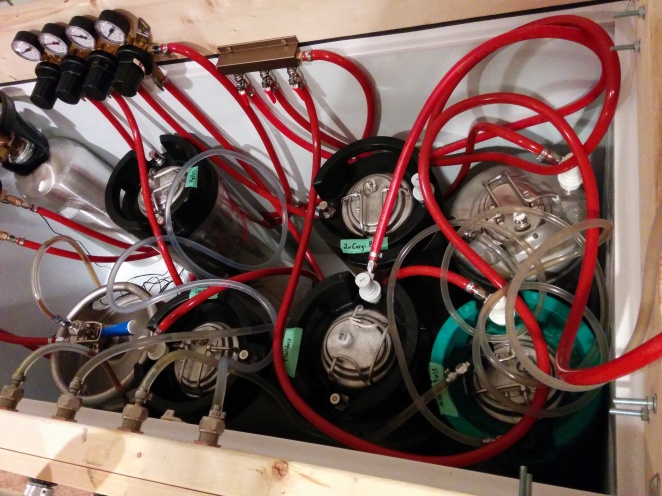Before I start posting about recipes and brew days I thought it would be a good idea to start with a post about my setup and an explanation of how I do things at a high level. In the interest of making this post digestible I am going to skip over some of the details and explain them as I go.
First thing’s first, here is my brewery (image below). My favourite thing about it is that I can leave it set up, which saves considerable time on brew day. The heart of my brewery is a 10 gallon stainless kettle (Bayou Classic 1040) and a 10 gallon Igloo cooler with false bottom. My setup is very similar to most people’s turkey fryer and cooler setup, I batch sparge in a cooler, and boil in a 10 gallon kettle. The kettle is heated by a 3500W induction cooktop (Avantco 3500) which is plugged into a 40 A stove outlet (via a custom adapter cord). I have a vent hood to allow steam to escape during the boil, powered by a Vortex VTX600 fan capable of 452 CFM. There is also a stainless sink (from kijiji) and pre rinse faucet to wash up, and few other things I’ll get around to explaining over time.
Under the brew table you can see my pump and chiller setup. My kettle has two valves so that I can whirlpool while chilling. When chilling a non-hoppy beer, I hook up my hoses, knockout at the 0 min mark, then kick on the pump to recirculate boiling wort through the chiller. When the output of the chiller reads above 180*F I turn on the chilling water and recirculate until the output of the chiller matches my pitching temp. Though I usually need to chill further in my fermentation chamber for lagers.
I am a big believer in precise fermentation control so I have dedicated two mini fridges to the cause. Each batch is independently controlled and can be heated and cooled. I usually pitch lower than fermentation temperature, hold at target temperature, then ramp up towards the low 70’s. As you can see they comfortably fit 6 gallon carboys, these are the 4.5 cu ft Danby models.My fridge and shelf don’t need much explanation. My fridge holds harvested yeast and beer, and the freezer compartment holds vacuum sealed hops. I always make my starters larger than needed so that I can save some for the next batch. This way I can avoid mixing my harvested yeast with hop solids and excess protein. The brew shelf holds pretty much everything I haven’t found a nice spot for in my brewery. Empty fermentors are stored on the first two shelves, I use Better Bottles as much as I can. Empty growlers and swing tops, oxygen wand/tank, keg parts, pH meter and calibration solutions, it’s all on there.

Two starters going. A 2L on the left of WLP090 for a Robust Porter, a 4.5L of WLP833 on the right for a Doppelbock.
I store and mill my grain at the opposite end of the basement, in the cold room. I buy full sacks of grain through bulk buys run by a regional homebrew club. Keeps the costs down per batch, and allows me to have lots of grain options for when the inspiration strikes. Once a sack is opened I pour it into a pair of buckets. I like to think this is better than storing an open sack since there is a better seal, plus they stack nicely to reduce the footprint. My mill is a Monster MM3-2.0, recently acquired, but I am definitely loving it so far. I usually store my extra full sacks in the grey rubbermaid but I have an extra few sacks right now since the fall bulk buy just happened last weekend. Not pictured is a 75 lb capacity blade scale that I use to measure out grain bills, and a 1/2″ drive corded drill to run the mill. Also, my empties box is overflowing, I should probably work on returning those to the much hated recycling center, aka The Beer Store.
In the room next to the brewery I have my keezer and bottling station. I store my empty kegs next to the keezer, and also my carboys being used for long term aging (current a sour stout and a cider). The keezer itself can fit approximately 11 corny kegs, though I haven’t tried yet. It has a 4 output secondary regulator so I can set unique serving pressures for each keg. I use the mirror behind the keezer as the tap list, writing the beer menu on it using window marker. The bottling station is currently just a wobbly shelf that hold my vinator, beer gun, and other bottling accessories.Thanks for reading, if you have any questions about my setup please don’t hesitate to ask them in the comments below! I’ll be sure to elaborate on the more important parts in future posts about brew days.

![DSC_2430[1]](https://ericbrews.com/wp-content/uploads/2014/11/dsc_24301.jpg?w=662&h=438)

![DSC_2428[1]](https://ericbrews.com/wp-content/uploads/2014/11/dsc_24281.jpg?w=662&h=438)
![DSC_2424[1]](https://ericbrews.com/wp-content/uploads/2014/11/dsc_24241.jpg?w=662&h=438)
![DSC_2431[1]](https://ericbrews.com/wp-content/uploads/2014/11/dsc_24311.jpg?w=662&h=438)

Awesome space and setup. Really jealous. I’m a garage brewer, so I have to set up and break it down every time because my GF wants to actually park in the garage. Crazy, right?
LikeLike
Still better than brewing in the kitchen! When I used to do that, I would have to spend 30 minutes doing dishes before I could even start brewing!
LikeLiked by 1 person
Really cool brew blog man. Nice set up too! Looks like your whole basement is dedicated to brewing! Living the dream 😛
LikeLiked by 1 person
I thought I was lucky to have the 3rd bay of my garage, you have a whole damn basement for yourself! Fortunately, like you, I don’t have to break down and put away all of my gear on brew day.
LikeLiked by 1 person
I am sure am lucky! My fiancée is very supportive, plus our house is way too big for our needs right now since we have no kids. I honestly don’t know what we would do with the basement if I didn’t need it for a brewery.
Thanks for reading the blog! Still getting the hang of things, my goal is to eventually only post about a beer once I have it carbed and conditioned so I can describe everything in one post.
LikeLiked by 1 person
A grain to glass series would be rad.
LikeLike
Man, I am jealous of folks with basements. I have neither a basement, nor a garage to brew in, I have to schlep my gear out the the back yard and back every time a brew.
Great writeup, looking forward to more posts!
LikeLike
Just stumbled upon your blog, really great stuff! I am slowly trying to work my brewery into the basement. Unfortunately, my available space is significantly smaller. Rather be cramped than out in the elements!
LikeLike
Eric, I noticed you have good ventilation. I brew in my laundry room and just open a window with a fan. I doesn’t really work that well since I brew down there in the winter and in my garage in the summer. I have Costco shelves for my grain and can’t store grain below the second rack as mice are a problem. I am in the process of buying 12 buckets to store my grains in from the SOB malt buy.
LikeLike
Hi Eric. I’m working setting up similar system. I have purchased a 3k watt induction cooktop Max Burton. I’d be interested in hearing about how you use the two 3 piece valves for whirlpooL. Do you also pump wort when step mashing on the Avantco. Or for maintaining mash temps. Nice setup. I like the ventilation hood extraction fan too
LikeLike
Hi MJ, I actually mash in the cooler so the Avantco doesn’t come into play for maintaining mash temps. As for the two valves for whirlpooling, I pump out of the bottom dip tube, through the convoluted counterflow chiller, then back into the kettle through the whirlpool arm. I get a pretty decent cone formation as you can see in my Robust Porter post: https://ericbrews.com/2014/11/19/robust-porter-2-0-plummers-porter/
Thanks for reading, let me know if you have more questions!
LikeLike
Really like the setup! Just wondering what do you use as a heating element in the mini fridges for fermentation?
LikeLike
I use reptile heating pads. Just stuck to the side of the inside of the fridge.
LikeLike
Nice setup! Where did you get the Danby fridges that have no freezer compartment?
LikeLike
Kijiji!
Though they can be found in store too. Just look for the 4.4 cu ft ones.
LikeLike